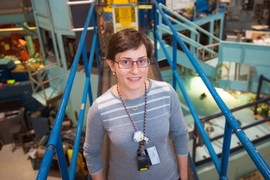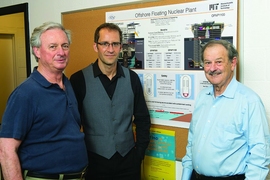The MIT Energy Initiative continues to develop and expand its eight Low-Carbon Energy Centers, which facilitate multidisciplinary collaboration among MIT researchers, industry, and government to advance research in technology areas critical to addressing climate change. Below, the co-directors of the Center for Advanced Nuclear Energy Systems discuss their vision for transforming the energy system.
Q: How can advanced nuclear energy systems research help the world reach its goal of reducing carbon emissions?
A: Today, fossil fuel–based power generation and transportation systems are major contributors to the all-time-high levels of atmospheric carbon dioxide. To address the potentially devastating impacts of climate change, future systems will need to produce very low or even zero carbon emissions — and scale up within a short time horizon: less than 35 years.
Nuclear fission is uniquely positioned to help meet this challenge because it has the highest energy density of any power source and its growth potential is not limited by resource availability. Nuclear power can also scale up quickly to fulfill high demand with zero carbon emissions.
The potential applications are wide-reaching. Not only can nuclear power be harnessed to meet the world’s growing demand for electricity, it could be used to decarbonize the transportation sector by providing the power and heat necessary to operate electric cars or produce synthetic fuels.
Q: What are the major challenges to the expanded use of nuclear energy, and how will the Center for Advanced Nuclear Energy Systems (CANES) address them?
A: While nuclear fission is already a leading source of zero-carbon energy, providing approximately 12 percent of power generation worldwide, progress toward expansion has been stymied by several factors. There are substantial capital costs and regulatory hurdles associated with contemporary reactor designs; rare but serious accidents have exacerbated concerns about plant safety — in spite of the industry’s robust safety record; and questions regarding waste and proliferation continue to temper the public’s enthusiasm for nuclear energy.
CANES aims to address these issues by hastening the development of new and transformative technologies, materials, and methods that will make nuclear fission more affordable and more rapidly and securely deployable. Building upon MIT’s already extensive capability in nuclear fission-related innovation, the center supports work across the entire technology development arc — from basic materials research through to reactor design, manufacturing, and the fuel cycle.
The center also pairs its innovative research with a dedicated technologic, economic, and systems analysis program focused on how best to overcome the challenges involved in expanding nuclear power. An MIT team is conducting technology assessments, economic modeling, and analyses of the regulatory, financial, and political aspects of siting, designing, constructing, operating, and decommissioning nuclear facilities.
Q: What kind of research is currently underway at the center?
A: CANES research centers on the real-world needs identified by MITEI’s partners in industry and builds upon established tools of nuclear research, including our on-campus 6-megawatt research reactor and state-of-the-art experimental facilities.
Projects currently underway range from advances in reactor design, materials, and operation to regulatory innovations that will continue to ensure a robust level of safety for nuclear systems, accelerate the nuclear innovation cycle, and promote private investment in new nuclear technologies.
Recent examples of MIT work include advances in light-water-reactor materials that can help increase the reliability and decrease the operating costs of existing plants; research into the possibility of permanently sequestering high-level radioactive waste in deep granite boreholes; and development of a risk-informed, performance-based regulatory framework that could facilitate the licensing of innovative new reactor designs. MIT researchers are also developing a design for an offshore floating nuclear plant that promises to be less expensive and easier to deploy than today’s land-based plants.
This article appears in the Autumn 2017 issue of Energy Futures, the magazine of the MIT Energy Initiative.









